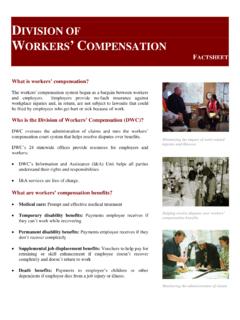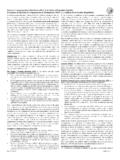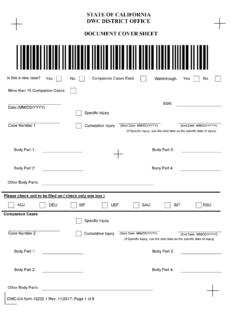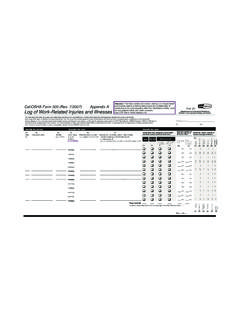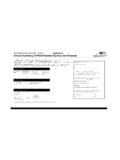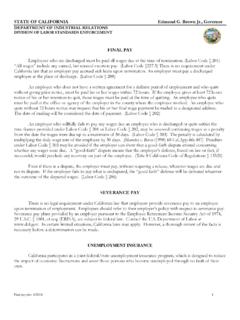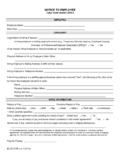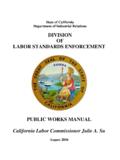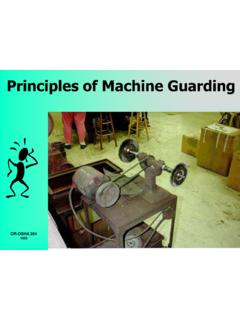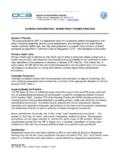Transcription of State of California Department of Industrial Relations ...
1 State of California Department of Industrial Relations division of Workers' compensation Physician's Guide to Medical Practice in the California Workers' compensation System Fourth Edition, 2016. Contents Commonly Used Acronyms vii Introduction to the Fourth Edition viii Chapter 1. The California Workers' compensation System 1. History of Workers' compensation 1. The Historic Compromise: A Trade-Off Between Employers and Employees 1. Exceptions to the No Fault Rule 2. Evolution of Workers' compensation in California 2. Chapter 2. Organization of the Workers' compensation System within State Government 4. California 's division of Workers' compensation (DWC) 5. The Workers' compensation Appeals Board (WCAB) 5. The Audit and Enforcement Unit 5. Disability Evaluation Unit (DEU) 6. Information & Assistance (I&A) Unit 6. Medical Unit 6. Workers' compensation Information System (WCIS) 7.
2 Uninsured Employers Benefits Trust Fund (UEBTF) and Subsequent Injuries Benefits Trust Fund (SIBTF) 7. Chapter 3. Compensability 8. How to Take a Complete Occupational History 8. What Is an Injury ? 9. Excluded Injuries 9. What Is a Compensable Injury? 10. What Is Considered an Aggravation of a Pre-Existing Non- Industrial Condition? 10. What Is the Date of Injury and Why Is It Important? 11. Is the Injury Work-Related (AOE/COE)? 11. Arising Out of Employment (AOE) 11. Analyzing Causation 12. Causation: Cumulative Injuries and Illnesses 13. What Is the Effect of Other Risk Factors on the Cause of the Injury? 14. Establishing the Cause of Cumulative Injuries and Illnesses 14. i Contents Occurring in the Course of Employment (COE) 15. Presumptions About Work-Related Injuries for Certain Groups of Employees 16. compensation for Psychiatric Injuries 17. Perception Is Not Disability 18.
3 How to Determine Causation for Psychiatric Injuries 18. What Happens If a Claim Is Filed After Notice of Termination or Layoff? 18. Chapter 4. Participants in the System 20. Employees 20. Employers 21. Insurance Carriers and Claims Administrators 21. Claims Administrator 22. Communicating with the Claims Administrator 22. Other Providers of Medical Goods and Services 23. Physicians 23. Attorneys 23. Chapter 5. Benefits and Payments to Employees 24. Medical Treatment 24. Temporary Disability Payments 25. Permanent Disability Payments 25. Supplemental Job Displacement Benefits 26. Return-to-Work Fund 26. Death Benefits 27. Initiating Benefits: Employee, Employer, and Physician 27. Discrimination Not Allowed 27. Chapter 6. The Role/Duties of the Physician 29. Primary and Secondary Treating Physician 29. How a Physician Becomes Part of Caring for Injured Workers 30. Health Care Organizations (HCOs) 32.
4 Predesignated Physician 33. Self-Referrals and Cross Referrals 33. Use of Physician or Psychological Assistants and Nurse Practitioners 35. ii Contents Chapter 7. Reports and Timelines in the System 36. Importance of Timely Reports 36. Doctor's First Report of Occupational Injury or Illness 36. Progress Reports or Other Periodic Reports 37. Request for Authorization (RFA) 39. Permanent and Stationary Form (PR-3 or PR-4) 39. Chapter 8. Evidence-Based Medical Guidelines and the Medical Treatment Utilization Schedule 41. Clinical Topics 42. Presumption of Correctness 42. Functional Improvement 43. Delayed Recovery and Early Intervention 44. Medical Evidence Evaluation Advisory Committee (MEEAC) 45. Chapter 9. Utilization Review (UR) and Independent Medical Review (IMR) 46. Introduction 46. Requesting Treatment 46. The UR Process: Who Reviews Requests? 46. The UR Process: Gathering Relevant Information 47.
5 Independent Medical Review (IMR) 49. IMR Application 50. Review of Eligibility and Assignment 50. Terminations 50. IMR Decisions 51. Appeal of IMR Decision 51. Chapter 10. Evaluating Permanent Disability 53. Physicians' Disability Evaluations 53. How Disability Evaluations Are Obtained (QME Process) 54. How Disability Evaluations Are Used 54. Guidelines for Conducting a Disability Evaluation Using the AMA Guides 55. AMA Guides: Impairment 56. AMA Guides: Disability 56. AMA Guides: Organ System and Whole Body Approach to Impairment 57. iii Contents AMA Guides: Concept of Combined Values Chart 57. AMA Guides: Pain 58. AMA Guides: The Spine 58. AMA Guides: Consistency 59. AMA Guides: Assistive Devices 59. AMA Guides: Adjustments for Treatment or Lack of Treatment 59. AMA Guides: Documentation 60. Almaraz/Guzman Standard 60. Chapter 11. Disputes in the System and the Role of the QME and AME 61.
6 Introduction 61. Who Are Medical-Legal Evaluating Physicians? 61. When Are Medical-Legal Evaluations Required? 62. How Do Workers Get a QME Exam 62. Unrepresented Employees 62. Represented Employees 63. Permanent Disability and the Need for Future Medical Care 63. Evaluations to Resolve Other Disputes 63. Resolving Disputes Over Medical-Legal Bills 64. Chapter 12. Writing the Medical-Legal Report 65. Introduction 65. Required Elements of a Medical-Legal Report 65. Timeliness 76. Payment for the Report 76. Chapter 13. Payment of Physicians and the Official Medical Fee Schedule (OMFS), RBRVS, E-Billing, and IBR 77. Provider Billing and Payment 77. Procedure Coding 79. Diagnostic Coding: ICD-10 79. California Specific Codes 79. Paper Billing Forms 81. Electronic Billing Formats 82. Federal Health Insurance Portability and Accountability Act of 1996 (HIPAA) 82. iv Contents Payment Timeframes 82.
7 Resolving Billing Disputes: Request for Second Review and Independent Bill Review 82. Chapter 14. Monitoring Compliance with the Rules and Enforcement of Compliance 85. Claims Administrator Audits 85. Utilization Review Investigations 85. Oversight of Medical Provider Networks and Health Care Organizations 86. Qualified Medical Evaluator Oversight 86. Discipline of Qualified Medical Evaluators 86. Treating Physicians 87. Employers 88. Chapter 15. Physician Conduct and Ethics Involving Medical-Legal Evaluations 89. The Physician's Conduct 89. Treating Physicians as Evaluators 89. The Scope of the Exam 90. What Are the Legal Responsibilities of the QME When Conducting a Medical-Legal Evaluation? 91. The Physician's Perspective 91. Interpreters 92. Can Injured Workers Bring Someone to the Exam? 92. Can Injured Workers Record the Exam? 94. Inappropriate Remarks/Joking 94. The Length of the QME Exam 94.
8 When Can a QME Exam Be Terminated? 95. Can a Medical-Legal Evaluating Physician Become a Treating Physician? 95. With Whom May a Physician Communicate When Conducting an Evaluation? 96. Referrals and Diagnostic Tests 97. Ethics 99. HIPAA 101. California HIV/AIDS Laws Workers' compensation 101. Impartiality 102. Malpractice 103. Fraudulent Workers' compensation Claims 103. v Contents What Constitutes Appropriate Advertising for QMEs? 104. Conflicts of Interest 105. Chapter 16. Information for Office Staff 106. Introduction 106. Assisting the Injured worker 106. Staff at the Treating Physician's Office 106. How QME Panel Appointments Are Arranged 106. Key Reminders 108. Obtaining Medical Records 108. Make Sure the Injured worker Has Completed DEU Forms 100 and 101 108. The Total Package 108. Serving the Report 109. Timeframes for Serving QME Reports 109. Billing and Independent Bill Review 110.
9 Independent Bill Review (IBR) 110. How to Withdraw an IBR Request 112. Can the IBR Determination Be Appealed? 112. IBR Resources and Forms 112. Glossary of Workers' compensation Terms 113. vi Commonly Used Acronyms 8 CCR California Code of Regulations, Title 8. ACOEM American College of Occupational and Environmental Medicine AD administrative director AMA American Medical Association AME Agreed Medical Evaluator AOE arising out of employment CF conversion factor CMS Centers for Medicare and Medicaid Services COE course of employment DEU Disability Evaluation Unit DIR division of Industrial Relations DOI date of injury DOSH division of Occupational Safety and Health DWC Department of Workers' compensation EBM evidence-based medicine EOR Explanation of Review GAF Global Assessment of Function HCO health care organization IBR independent bill review IBRO independent bill review organization IMR independent medical review MEEAC Medical Evidence Evaluation Advisory Committee MPN medical provider network MPPR Multiple Procedure Payment Reduction MTUS medical treatment utilization schedule OMFS Official Medical Fee Schedule OSHA
10 Occupational Safety and Health Administration PA physician's assistant P&S Permanent and Stationary PTP primary treating physician QME Qualified Medical Examiner RBRVS Resource-Based Relative Value Scale RVUs Relative Value Units SIBTF Subsequent Injuries Benefits Trust Fund SJDB Supplemental Job Displacement Benefits TD Temporary Disability TPD Temporary Partial Disability TTD Temporary Total Disability TPA third-party administrator UEBTF Uninsured Employers Benefits Trust Fund UR utilization review URO utilization review organizations WCAB Workers' compensation Appeals Board WPI Whole Person Impairment vii Introduction to the Fourth Edition This edition of the Physician's Guide to Medical Practice in the California Workers' compensation Sys- tem (Physician's Guide) has been developed by the division of Workers' compensation (DWC) to continue the mission set forth in the first three editions of the Physician's Guide, namely, to assist physicians in understanding the many complexities in the California workers' compensation system in order to provide optimal care to ill and injured workers.
